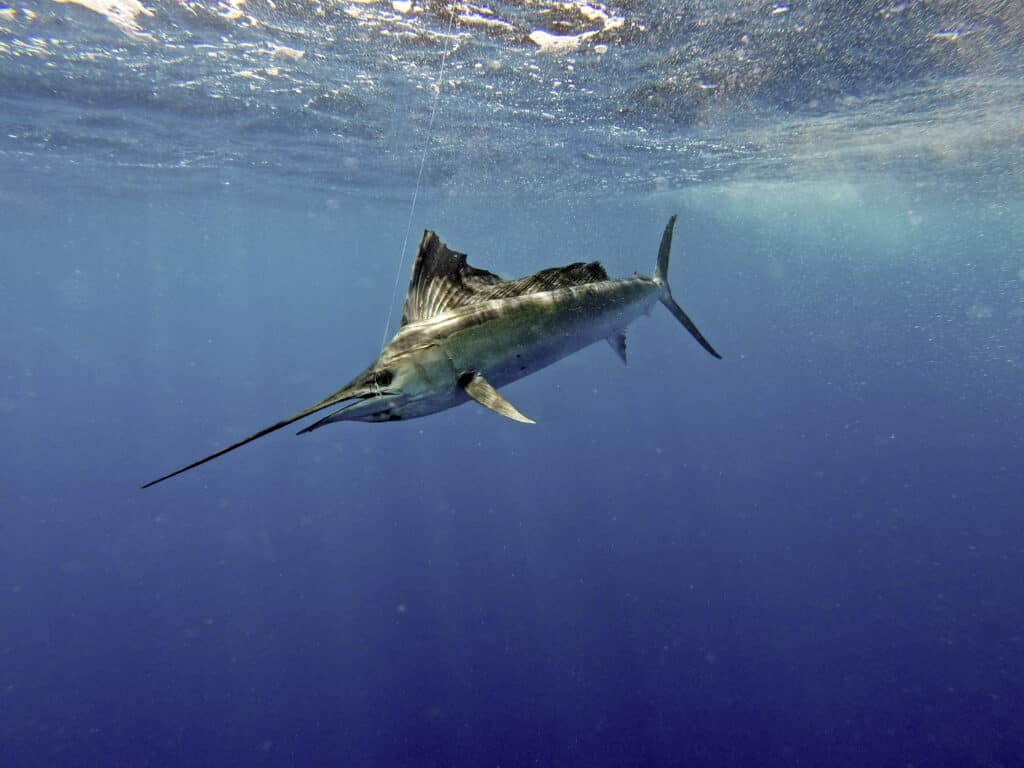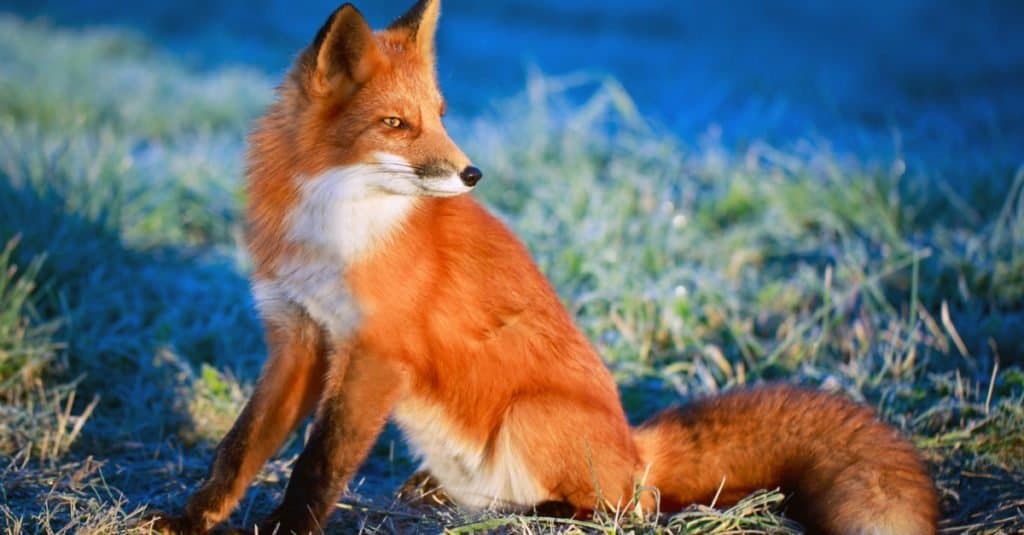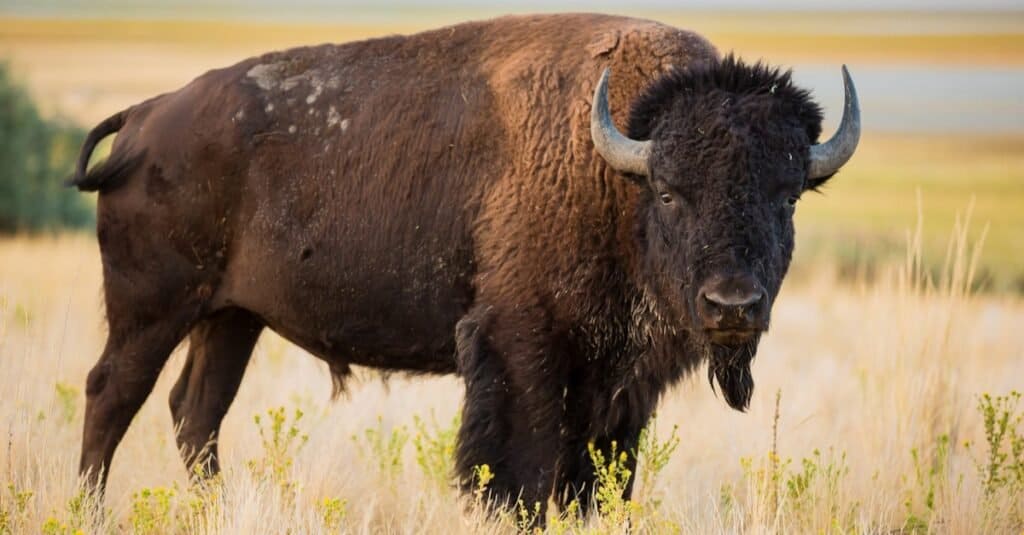Despite the extreme temperatures and harsh landscape, Alaska has diverse wildlife on land, sea, and air. Birds, like falcons and eagles, are the fastest animals in the world. But to give this article some diversity, I’ve included fish and land animals. Many of the world’s fastest creatures are predators, but Alaskan prey animals must be swift to outrun creatures like bears and wolves. Discover the fastest animals in Alaska, including both predator and prey.
1. Peregrine Falcon (and Other Birds)

The
Peregrine Falcon
has a streamlined body with pointed wings, which fold near its sides to gain more speed.
©Harry Collins Photography/Shutterstock.com
The peregrine falcon is the fastest animal in the world, reaching speeds up to 240 Mph as it dives in the air for its prey. These birds of prey inhabit every continent except Antarctica and can be found along Alaska’s coastline. This falcon has a streamlined body with pointed wings, which fold near its sides to gain more speed. It’s faster than a speeding bullet, and everything about its body, including its circulatory and respiratory systems, can handle these extreme speeds. Most of the fastest animals on earth are birds, and Alaska has many exceedingly speedy species, including the golden eagle (200 Mph), spine-tailed swift (100 Mph), and green-winged teal (60 Mph).
2. Sailfish

The
sailfish
evolved over time to become hydrodynamic, with a long pointy nose, sail-like dorsal fin, and torpedo-shaped body.
©kelldallfall/Shutterstock.com
The sailfish is one of the fastest fish in the ocean, reaching almost 70 Mph as they dart towards their prey. Arctic graylings are the sailfish in the north, and they inhabit Alaska’s unsalted rivers that drain into the Bering Sea and the Arctic Ocean. The sailfish evolved over time to become hydrodynamic, with a long pointy nose, sail-like dorsal fin, and torpedo-shaped body. It also folds its fins against its body to further reduce drag.
3. Caribou (Reindeer)

Caribou
are excellent runners and swimmers with large, concave hoofs that spread, helping support their weight on snow and ice.
©Jeff McGraw/Shutterstock.com
The caribou is the fastest land animal in Alaska, reaching speeds up to 50 Mph! These reindeer inhabit arctic tundra, mountains, and boreal forests, with herds dispersed throughout the state. They are excellent runners and swimmers and have large, concave hoofs that spread, helping support their weight on snow and ice. And they function as paddles when they swim. These animals are born to run; their young can be up and running 90 minutes after birth.
4. Coyote

Coyotes
are extremely bold predators who will sometimes attack pets right in the presence of one or more humans.
©Jukka Jantunen/Shutterstock.com
Coyotes can run up to 43 Mph and can jump distances of over 13 feet. Their average traveling speed is around 20 Mph, but they can reach these impressive speeds when fleeing danger or taking out prey. These wild dogs live in the southeast and much of interior Alaska, where they inhabit valleys and the Kenai peninsula. The coyote has to be fast to outrun predators like wolves and keep up with prey like hares and deer.
5. Wolf

Wolves are powerful and can take down prey easily by sprinting for short distances.
©nataliatamkovich/Shutterstock.com
Wolves can run up to 38 Mph for short bursts at a sprint but typically travel around 5 Mph when covering long distances. They are common throughout most of mainland Alaska’s arctic tundra and national forests. Wolves are powerful and can take down prey easily by sprinting for short distances, but they are not built to sustain those speeds over long periods. Often, they take advantage of vulnerable individuals as their prey has adapted well to protect themselves.
6. Grizzly Bear

It is important to
stand tall
, act intimidating, and never run away if a bear is approaching you.
©Perpis/Shutterstock.com
The grizzly bear is the fastest in the bear family, reaching speeds up to 35 Mph. They can sprint at their top speed for short distances but maintain a comfortable pace between 25 and 28 mph for several miles. Grizzlies live in the Arctic and interior regions of Alaska in woodlands, forests, and alpine meadows. These large predators are built for speed, with huge, muscular legs that propel them forward. They also have longer back legs that aid in their swiftness. While they look fatty, their bodies are solid and surprisingly agile.
7. Red Fox

Red foxes
play among themselves, as well as with other animals.
©DragoNika/Shutterstock.com
Red foxes can run up to 30 mph and leap as high as six feet. However, they spend most of their time walking and trotting, and their max speeds are maintained only for short periods, typically when escaping predators or hunting prey. The red fox lives in the Arctic tundra and crisscrossed hills throughout most of Alaska except for some areas in the southeast. These foxes evolved to be quick to outrun predators and catch their food, such as birds and rabbits.
8. Black Bear

Black bears
cover most of the forested areas in Alaska, with a large concentration in Southeast Alaska on northern Kuiu Island.
©BGSmith/Shutterstock.com
Black bears can run 30 to 35 mph and are the second fastest in the bear family. Like their bigger cousins, the grizzlies, they can reach their top speeds for short distances (450 feet) when running from potential danger or catching prey. Black bears cover most of the forested areas in Alaska, with a large concentration in Southeast Alaska on northern Kuiu Island. Like other bears, black bears have huge, muscular legs that propel their heavy bodies forward at a considerable speed. They tire more quickly during the winter when they pack on weight for hibernation.
9. Arctic Hare

The
arctic hare
lives in western coastal Alaska and the Alaskan Peninsula, inhabiting tundra, alluvial plains, and coastal lowlands.
©Sophia Granchinho/Shutterstock.com
Arctic hares can run up to 30 to 40 mph and leap six to ten feet in one bound. These hares can sustain these short bursts of incredible speed when evading predators, making them tough to catch for even the strongest predators. The arctic hare lives in western coastal Alaska and the Alaskan Peninsula, inhabiting tundra, alluvial plains, and coastal lowlands. They have tall, muscular hind legs and oversized feet, allowing them to dig into packed snow and drive forward.
10. Bison

American Bison are the largest mammal in
North America
.
©O.S. Fisher/Shutterstock.com
The bison is remarkably agile, leaping vertically over six-foot-high fences and reaching up to 35 mph when running. Despite their enormous size, these animals are as swift as a racehorse. Bison are common land animals in Alaska, covering much of the state, especially in boreal forest regions. Use caution when around a bison. They may look slow but can charge at a moment’s notice, using their one-ton bodies to hurl themselves at their targets.
Up Next:
- The Fastest Animals In The World (Faster Than A Ferrari!?)
- The 10 Fastest Animals In North America
- The Top 10 Fastest Sea Animals
The photo featured at the top of this post is © iStock.com/Svetlana Belkina
Thank you for reading! Have some feedback for us? Contact the AZ Animals editorial team.






